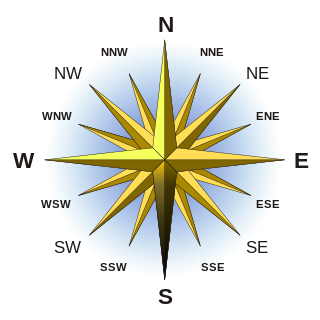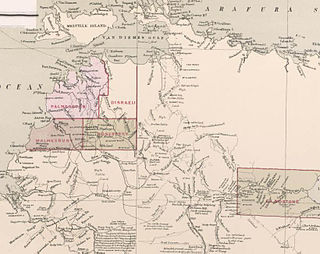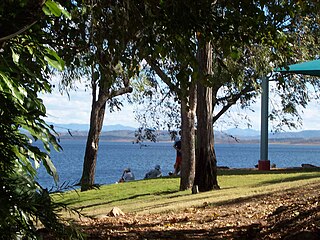

The Hundred of Glynne was a Hundred of Gladstone County, Northern Territory Australia. [2]
A hundred is an administrative division that is geographically part of a larger region. It was formerly used in England, Wales, some parts of the United States, Denmark, Southern Schleswig, Sweden, Finland, Estonia, and Norway. It is still used in other places, including South Australia, and The Northern Territory.

The Northern Territory is an Australian territory in the central and central northern regions of Australia. It shares borders with Western Australia to the west, South Australia to the south, and Queensland to the east. To the north, the territory looks out to the Timor Sea, the Arafura Sea and the Gulf of Carpentaria, including Western New Guinea and other Indonesian islands. The NT covers 1,349,129 square kilometres (520,902 sq mi), making it the third-largest Australian federal division, and the 11th-largest country subdivision in the world. It is sparsely populated, with a population of only 246,700, making it the least-populous of Australia's eight states and major territories, with fewer than half as many people as Tasmania.
It is located 600 km southeast of Darwin, at Latitude: -14° 38' S and Longitude: 134° 48' E and It was named after the wife of British Prime Minister William Ewart Gladstone, Catherine Glynne.

South is one of the four cardinal directions or compass points. South is the opposite of north and is perpendicular to the east and west.

Darwin is the capital city of the Northern Territory of Australia, situated on the Timor Sea. It is the largest city in the sparsely populated Northern Territory, with a population of 145,916. It is the smallest, wettest and most northerly of the Australian capital cities, and acts as the Top End's regional centre.

A wife is a female partner in a continuing marital relationship.
The only town in the former Hundred is the small settlement of Ngukurr.

Ngukurr is a remote Aboriginal community on the banks of the Roper River in southern Arnhem Land, Northern Territory. A number of different clans and language groups are represented in the town, with Kriol being the main language spoken. Collectively, indigenous peoples in the Roper River area refer to themselves as Yugul Mangi, and the Yugul Mangi Aboriginal Corporation works closely with the Roper Gulf Regional Council to provide services and economic opportunities in Ngukurr and surrounding areas.
The first European to see the Hundred was Ludwig Leichhardt who crossed the Roper River at the Roper Bar in 1845, and in 1855 Augustus Charles Gregory passed to the south of the Hundred on his route to Gladstone, Queensland. This Hundred was one of just 6 Hundreds in the County of Gladstone (located in the Roper River area) which was gazetted 09/01/1873. Each of these hundreds was designed to be roughly 10 miles by 10 miles in area though some variation occurred due to the river course.

Europe is a continent located entirely in the Northern Hemisphere and mostly in the Eastern Hemisphere. It is bordered by the Arctic Ocean to the north, the Atlantic Ocean to the west and the Mediterranean Sea to the south. It comprises the westernmost part of Eurasia.

Friedrich Wilhelm Ludwig Leichhardt, known as Ludwig Leichhardt, was a German explorer and naturalist, most famous for his exploration of northern and central Australia.

Roper Bar is a location in Australia's Northern Territory. It lies on the traditional land of the Ngalakgan people who used the placename Yurlhbunji to refer to Roper Bar. This part of Australia is extremely remote for travellers although there are a number of Aboriginal communities in the region including Ngukurr, Urapunga and Minyerri. A 4WD trek through these parts can be an extension of the Gulf Track on a journey further up north to Darwin or Arnhem Land.
The Hundred lapsed with the passage in 1976 and subsequent assent of the Crown Lands Ordinace 1976 (No 1 of 1977) and the Crown Lands (Validation of Proclamations) Ordinance 1976. In 2012 the souther fringe of the hundred was incorporated into the Limmen National Park.

Limmen National Park, announced in 2012, is the second largest in Australia covering 10,000 square kilometres (3,900 sq mi) in the Northern Territory. Located about 600 km south-east of Darwin on the Gulf of Carpentaria, the park incorporates wetlands, sandstone structures and numerous rivers, including the Limmen Bight River from which the park takes its name. A major attraction in the park are the 'Lost Cities'—sandstone rock formations resembling tall apartment blocks.











